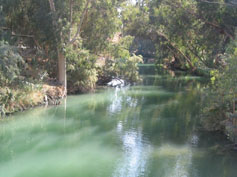 |
Doctrine of Baptisms |
Is baptism a ritual of initiation in which a novice is placed under water for the removal of his sin, or is there much more to it? The Bible reveals that there is more than one kind of baptism, but there is only one, which is correct for Christians.
The right form of baptism is described in Acts 2:38. “Repent, and be baptized every one of you in the name of Jesus Christ for the remission of sins, and you shall receive the gift of the Holy Spirit.”
Baptism of the Holy Spirit
However, when we read about the doctrines of Jesus, we find a number of other types of baptisms (plural) being spoken of (Hebrews 6:1). What are these other types of baptisms? Are they important for our salvation? We can clearly see that this verse shows that there is more than one kind of baptism.
There are three different baptisms which are mentioned in Matthew 3:11. The first is the baptism performed by John the Baptist which was with water unto repentance. The second is the baptism in which Jesus baptizes with the Holy Spirit. And the third is the baptism in which Jesus baptizes with fire.
In today’s confused world, we find all kinds of wrong practices when it comes to baptism. Some Sunday-keepers are baptized without having repented of their Sabbath-breaking. Some people baptize their infants or young children, and some baptisms consist of pouring or sprinkling a little water over the head. All these kinds of baptisms are wrong and not Scriptural. But be assured, these wrong forms of baptism are not the “baptisms” referred to in the doctrines of Christ (Hebrews 6:1).
John the Baptist was the voice crying in the wilderness saying: “Prepare ye the way of the Lord.” (Matthew 3:3) The baptisms performed by John were incomplete in that they were not unto salvation, though John did baptize and preach the baptism of repentance for the remission of sins (Mark 1:4). Those who were baptized by John, and later became Christians, had to be re-baptized in the name of Jesus Christ (Acts 19:3-5).
The Meaning of Baptism
When most people think about baptism, they usually imagine some kind of sacrament or ceremony. When asked to explain what baptism is, many would use expressions such as, christening, consecration or sanctification. Baptism had become a recognized rite among the Jews long before God the Father directed John the Baptist to baptize with water (John 1:33, Matthew 21:25). It was a long-standing custom for Gentile proselytes to be purified by immersion and symbolically washed clean in a ritualistic baptism, before being accepted into Judaism. “Baptism” means to put within and under by immersion. Originally, ‘baptizo’ could refer to a sunken ship.
But, when Jesus spoke of “baptism,” He used it in a more harsh sense. “Baptism,” the way Jesus uses it, means to plunge completely into or under, to overcome, and to overwhelm.
It is important to understand what Jesus Christ meant when He utilized the word “baptize.” Surprisingly, Jesus gave us the example where water and getting wet were not involved at all! It took place when James and John came to Jesus, boldly asking Him for high positions in the Kingdom of God! Notice how Jesus answered them:
“You do not know what you are asking for: Can you drink of the cup that I drink of, and be baptized with the baptism that I am baptized with?” (Mark 10:38) Jesus asked them in effect, “Are you able to go through the suffering and ordeal of my scourging and crucifixion with me?” Jesus called His torture and death, “a baptism.”
James and John answered Jesus and said that they were capable of enduring His “baptism.” Referring to their future martyrdom, Jesus said unto them: “You shall indeed drink of the cup that I drink of; and with the baptism that I am baptized withal shall you be baptized.” (Mark 10:39) Compare also: Luke 12:50
Baptism – a Picture of Jesus’ Death
Jesus spoke of His death as a “baptism” that He and others would go through. Few realize that Jesus’ death is a picture of our own baptism! He laid down his life for the whole world (John 1:29). “Hereby perceive we the love of God, because He laid down his life for us: and we ought to lay down our lives for the brethren.” (1John 3:16) Jesus’ blood washes away our sins – not the water (Colossians 1:14).
Few understand that a valid Christian baptism contains that vital element – which is death! Paul expressed it this way: “Do you not know that so many of us as were baptized into Jesus Christ were baptized into His death?” (Romans 6:3) This is the true picture of baptism that so few people understand! Our baptism in water is only an outward symbol of our willingness to participate in the true baptism of Jesus’ death.
Paul further explains the reason that we are immersed under water in baptism. Baptism pictures, not only the removal of our sins as many recognize, but it is also an authentic depiction of our death and resurrection. “Therefore we are buried with him by baptism into death: that like as Christ was raised up from the dead by the glory of the Father, even so we also should walk in newness of life.” (Romans 6:4) We then walk in this “newness of life” by continuously being “living sacrifices” – by laying down our lives for the brethren (Romans 12:1).
“For if we have shared in the likeness of his death [through our own baptism], we shall be also in the likeness of his resurrection: Knowing this, that our old man [of sin] is crucified with him, that the body of sin might be destroyed, that henceforth we should not serve sin.” (Romans 6:5-6)
Baptism, then, is our pledge or covenant, that from thence we should walk in the newness of life and not serve sin. Some people erroneously think that once they have been baptized, they “have it made.” Not so! Our Christianity only begins with baptism.
Baptism by Fire
What about baptism by fire (Matthew 3:11)? Should baptism by fire be the most desired form of baptism? Does baptism by fire mean that the believer becomes zealously fired up, or on fire with a religious fervor? The baptism of fire is for incorrigible sinners. Notice this:
In the previous verse, Matthew 3:10, John referred to the unrighteous sinners, who without good fruit, are cut down and thrown into the fire. John goes on to show that it is Jesus who makes the separation between the righteous Christians (wheat), and unrepentant sinners (chaff). “Whose fan is in his hand, and he will thoroughly purge his floor, and gather his wheat into the garner; but he will burn up the chaff with unquenchable fire.” (Matthew 3:12)
This “unquenchable fire” is a reference to the final resurrection and judgment in the lake of fire (Revelation 20:15). “As therefore the tares are gathered and burned in the fire; so shall it be in the end of this world.” (Matthew 13:40)
When considering baptism, think past the burial of the “old man” by immersion in water with the subsequent remission of our sins, to the reality of the fuller meaning of being baptized into the death of Jesus Christ, and His life in us through the gift of the Holy Spirit. “There is one body, and one Spirit, even as ye are called in one hope of your calling; one Lord [Jesus Christ], one faith, one baptism, one God and Father of all.” (Ephesians 4:4-6)
At the end of His public ministry, Jesus commanded His disciples: “Go you therefore, and teach all nations, baptizing them into the name of the Father, and of the Son, and of the Holy Spirit.” (Matthew 28:19)
***
| Sermon: |
"Doctrine of Baptisms" |
 |
 |
| 